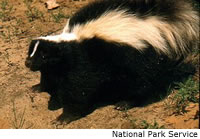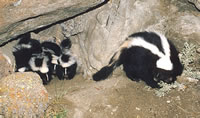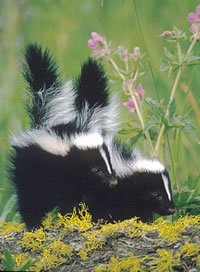Characteristics
 The
striped skunk is easily identified by the white stripe that runs from its
head to its tail. Its stripes start with a triangle at the head and break
into two stripes down its back. The stripes usually meet again and form one
stripe at the base of their tail. Their tails are usually a mixture of white
and black fur. Each striped skunk has a unique stripe pattern.
The
striped skunk is easily identified by the white stripe that runs from its
head to its tail. Its stripes start with a triangle at the head and break
into two stripes down its back. The stripes usually meet again and form one
stripe at the base of their tail. Their tails are usually a mixture of white
and black fur. Each striped skunk has a unique stripe pattern.
The striped skunk is about the same size as a house cat. It has a small triangular head and little ears. Its legs are short with webbed toes and claws the striped skunk uses for digging and looking for food.
The striped skunk is only found in North America. Its range runs from central Canada to northern Mexico.Habitat
The striped skunk tends to live in open areas with a mix of habitats like woods and grasslands or meadows. It is usually never further than two miles from water.Diet
The striped skunk is omnivorous, it eats both meat and plants. Its diet includes insects, small mammals, fish, crustaceans, fruits, nuts, leaves, grasses and carrion (dead animals). What a skunk eats often depends on what it can find and the time of year.
Life Cycle
 Striped
skunks mate from mid-February to mid-March. The babies are born about two
months later. An average skunk litter has five to six babies. Skunk babies
are blind and deaf when they are born. They will nurse in the den for about
a month and a half. After they leave the den they may stay with their mother
for up to a year.
Striped
skunks mate from mid-February to mid-March. The babies are born about two
months later. An average skunk litter has five to six babies. Skunk babies
are blind and deaf when they are born. They will nurse in the den for about
a month and a half. After they leave the den they may stay with their mother
for up to a year. Behavior
 With
their short, stubby legs, it isn't easy for a skunk to outrun a predator.
The striped skunk has developed a unique defense system. When a skunk is
threatened, it first tries to run away from the predator. If that doesn't
work, it tries to frighten the predator by arching its back, raising its
tail and turning its back on the predator. It may also stomp its feet. If
this doesn't work, as a last resort, the skunk will spray the animal with a
strong-smelling fluid. The fluid really stinks and it can also sting the
eyes of the predator. This gives the skunk time to get away! A skunk can
spray as far as twelve feet!
With
their short, stubby legs, it isn't easy for a skunk to outrun a predator.
The striped skunk has developed a unique defense system. When a skunk is
threatened, it first tries to run away from the predator. If that doesn't
work, it tries to frighten the predator by arching its back, raising its
tail and turning its back on the predator. It may also stomp its feet. If
this doesn't work, as a last resort, the skunk will spray the animal with a
strong-smelling fluid. The fluid really stinks and it can also sting the
eyes of the predator. This gives the skunk time to get away! A skunk can
spray as far as twelve feet!
The skunk is primarily nocturnal. It sleeps in its burrow during the day and hunts at night. It usually doesn't dig its own burrow. It looks for an abandoned burrow or finds a natural hollow under a tree or building.